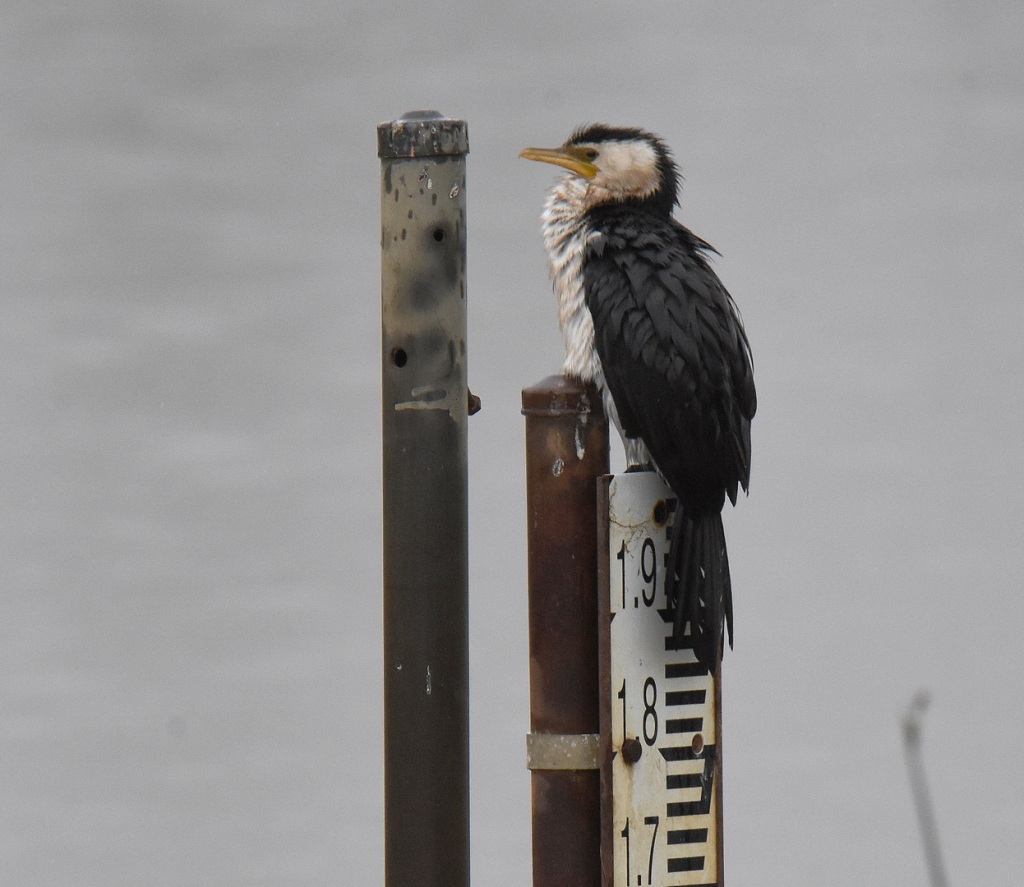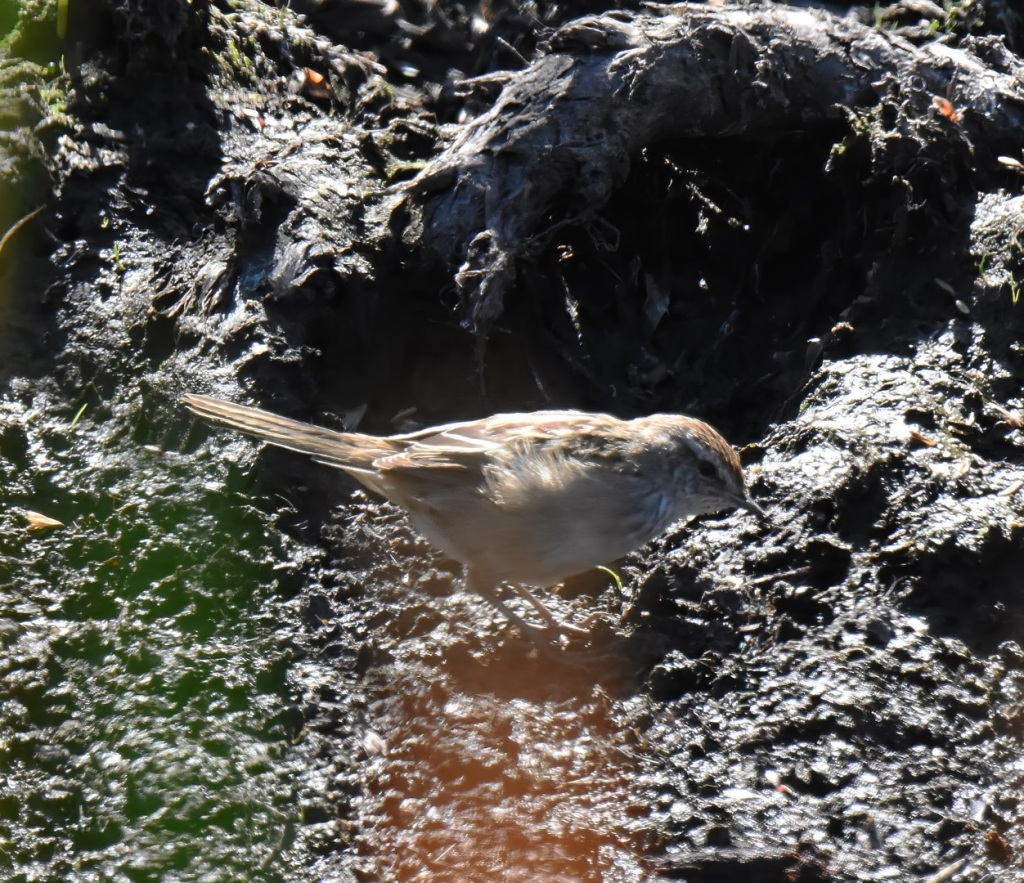13 March 2024
Leader: Robert Grosvenor
Wet mornings are always difficult decision times for birders and Wednesday the 13th was just such a morning. The rain, although patchy, was not expected to clear until lunch time. On arriving at the rough layby that serves as a parking area here, only a few cars were lined up. Our leader Robert was here and about 4 others. Gradually the numbers improved and when we set off soon after 10am we had a group of 14 keen birders. Thankfully, the rain was barely enough to colour the surface of the grassland that was showing the cracks that appear in the dry. The wind was very light, so no rain blowing into faces.
The Wetland here is a Melbourne Water Constructed Wetland. The following link provides some general information:
Constructed wetlands | Melbourne Water
Troups Creek is not a reserve or parkland in the everyday sense and as such it can be confusing to source information. The creek itself is at the Eastern end of the wetland and flows down from another Melbourne Water facility further North known as Troups Creek Retarding Basin. The following is the latest published report I could find that has data on this wetland. But note that it covers many other catchment areas and associated wetlands. Melbourne Birdlife is involved in conducting surveys at several sites in the Eumemmering Sub-catchment, and Troups Creek is one of these.
Microsoft Word – 2016-17 report_MWrbm_Final_Dec2107 (birdlife.org.au)
We began the survey list, as usual, from the car park while waiting for any late arrivals. There was a Little Pied Cormorant sitting quietly on a post in that part of the lake near the layby. However, it was having difficulty keeping the attention of the observers as the presence of a showy white duck, strutting its presence near the reeds, competed for “bird of the day”.


Meanwhile, Spotted Doves flew between the telegraph wires and the grassy patches, and Common Starlings lined up to be counted, along with a Little Raven. A lone common Myna sat above them on the telegraph pole. A few Australian White Ibis and some Purple Swamphen were foraging on the verge near the Hallam Valley main drain, and a Great Cormorant did a fly past.


Australian White Ibis
The wetland consists of a series of lakes surrounded by grassland that is cut from time to time. The lakes are generally fringed with reeds and sometimes have small islands. Tree cover is sparse with little to no very large old trees, but there are areas of shrubs and medium sized trees. In the distance high voltage power lines cross the Eastern side of the wetland. In essence, it is an open environment that favours waterbirds, but also supports those that forage on grassland.
We began by making our way to the North side of the lakes and traversing the grassland in a path that followed the water’s edge. This allowed us to monitor the wet areas and listen for small birds in the shrubs and trees that occur in places. We soon had Pacific Black Duck and White-faced Heron on the list.

Superb Fairy-wrens were often heard, and a few observers managed to see a group of 10 birds foraging in the reeds at water’s edge. A Red-browed Finch was noted but not seen by everyone. A single Eurasian Coot seemed content poking around in the reeds on the first lake, but the most obvious birds were the White Ibis and the Purple Swamphen.

An Australian Magpie and a Little Pied Cormorant made an unlikely pair on the limb of a small tree. White-plumed Honeyeaters were noted working the tops of the young Eucalypts, and a New Holland Honeyeater showed briefly.

For a relatively open landscape raptors were at a premium and none showed in the early part of the walk. Scanning ahead on the grassland revealed more White-faced Herons, some Masked Lapwings and two Magpie Larks.


Magpie-lark with tasty morsel (left) and after having eaten it (right)
The more Easterly lakes held Black Swan and a Great Egret presented well.

Dusky Moorhen were conspicuously absent and Eurasian Coot few and far between. The first Raptor to be spotted was a Black-shouldered Kite hovering beneath the power lines. Soon after we were able to witness the languid glide of four Australian Pelican as they flew into one of the lakes.


Australian Pelicans
We’d covered quite a lot of ground before being able to add further species to the list. Brown Thornbill and Red-browed Finch were working lakeside vegetation and Welcome Swallows were spotted over more open ground to the North. Scrutiny of these birds revealed the presence of two Fairy Martins. Back at the reeds some keen eyes got onto two Reed Warblers and a Little Grassbird showing well as they worked the edge of the reed bed.


Just behind them a Golden-headed Cisticola perched obligingly on the top of a grass stem. By now some of the lead group had got onto some roosting Nankeen Night Herons which we all eventually got a look at. The lake here also provided our first Teal…some Grey and some Chestnut.


Nankeen Night-Heron
Making our way around the far northeastern corner an Australian Kestrel was spotted perched at the top of a power pylon.

Goldfinch were spotted in the grass below but the hunt for Dusky Moorhen continued without success. Walking along the creek we noted another Great Egret, Little Black Cormorant, and a Black-shouldered Kite perched on a low shrub gave a good photo opportunity.




Black-shouldered Kite
We made our way back to the layby along the path next to the main Hallam drain noting two Willie Wagtails and Two Common Blackbird.

A female Australian Darter presented drain side and turned out to be the last notable sighting on our return leg.

We had a late lunch and did bird count at about 1.30pm. Our bird list for the day totalled 44 species. All in all, a very good outcome for what promised to be a rather drab day … but birding is never predictable and always enjoyable! The sightings have been entered into Bird Dta as a survey which is viewable via the link below:
http://birdata.birdlife.org.au/survey?id=9999538&h=11246c35
Photos kindly provided by Steve Hoptroff.
Phillip.